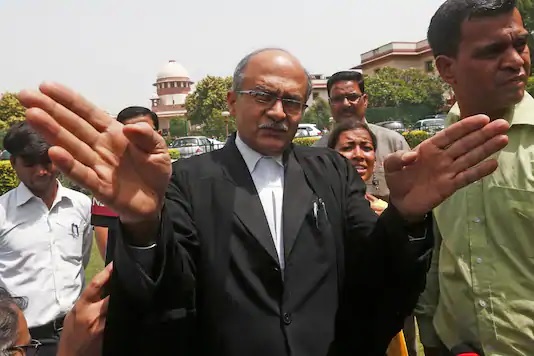
Update: Update: The Bench in its order stated that if the apology of Prashant Bhushan and Tarun Tejpal is not accepted by the bench, they will hear the matter. The order reads thus, “Explanation/apology submitted by Mr. Prashant Bhushan/ Respondent No.1 and Mr. Tarun Tejpal/Respondent No.2, have not been received so far. In case we do not accept the explanation/apology, we will hear the matter. We reserve the order.”
The August 4 Supreme court hearing on Prashant Bhushan contempt case which started off as an open court hearing later became an in-camera proceeding. The bench comprising Justices Arun Mishra, BR Gavai and Krishna Murari was hearing two contempt cases against Bhushan. One is an 11-year old case moved by Senior advocate Harish Salve and the other is a recent case whereby suo moto case was registered by the bench following two tweets posted by Bhushan. The legal news website, LiveLaw reported that following the off camera proceedings that ensued in the first half of the day, bench took up the issue in the afternoon and has reserved its orders.
Bar and Bench reported that the hearing of the 11-year old case began with Justice Mishra, who is leading the bench, speaking to Senior Advocate Rajeev Dhawan appearing for Bhushan, “There is freedom of speech and expression and then contempt. How do we save the grace of this system? I want to know from you as a amicus so that we can avoid this conflict”. To this, Dhawan responded, “Mr Bhushan has given an explanation. That explanation can put an end to this.” Justice Mishra also said that there is a thin line between contempt and freedom of speech and Bhushan may have crossed it.
Thereafter, hinting towards an in-camera hearing, Justice Mishra said to Dhawan, “This is between you and me” after which the mics were muted. Meanwhile, Dhawan and Justice Mishra spoke over the phone. An in-camera proceeding is one that does not allow an audience and media has no access to it. It is generally opted in cases of sexual offences or in cases under the Family Courts Act and other such personal laws. The presiding judge however, has the discretionary power to hold in-camera proceedings in any case if he deems it necessary.
It is pertinent to note here that the older case was pertaining to an interview given by Bhushan to Tehelka magazine way back in 2009 where he had said that half of the last 16 Chief Justices of India (CJI) were corrupt, while also maintaining in the interview that he no proof for his allegations. When the hearings began in January 2010, Bhushan’s father Shanti Bhushan had intervened and had submitted to the court in sealed cover, evidence against the former CJIs.
The recent case is about two tweets posted on social networking platform, Twitter by Bhushan. In the suo moto order, the bench had stated that the tweets “have brought the administration of justice in disrepute and are capable of undermining the dignity and authority of the Institution of Supreme Court in general and the office of the Chief Justice of India in particular, in the eyes of public at large”.
Bhushan, in an affidavit in response filed in the suo moto contempt case said that his “criticism has been outspoken yet it has been carefully weighed and made with the highest sense of responsibility”. He also said that “to assume or suggest that ‘the CJI is the SC, and the SC is the CJI’ is to undermine the institution of the Supreme Court of India.”
Related:
Chief Justice is not the court: Prashant Bhushan responds to contempt notice
A tale of two tweets: Contempt proceedings by SC against Prashant Bhushan
Concerned citizens urge SC to withdraw contempt case against Prashant Bhushan